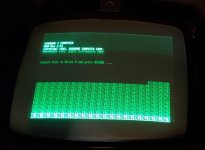booboo
Experienced Member
Seeking some ideas, as I've run out of options here...
Symptom: Osborne will not book any disk image from Gotek or floppy disk from drive A or B.
Background: I have a (new to me) Osborne OCC1A, with factory DD board and a Nuevo 80 column card. ROM 1.51. When booting, it seems to load track 1 and 2, then either:
Thoughts?
Sample screen but always changes....
Symptom: Osborne will not book any disk image from Gotek or floppy disk from drive A or B.
Background: I have a (new to me) Osborne OCC1A, with factory DD board and a Nuevo 80 column card. ROM 1.51. When booting, it seems to load track 1 and 2, then either:
- Stops reading disk or Gotek
- Spins disk or Gotek
- Prints garbage on the screen
- Removing the DD and 80-column options and installing ROM 1.44 makes no difference.
- Replacing the Z-80
- Replacing the Fujitsu FDC chip
- Booting from A, B (Shift "), and from a Gotek.
- I've tried the CP/M images Retrocmp (SSDD and SSSD).
- All exhibit some fashion of the same issue., in that there's no BOOT ERR but rather it loads just track 1 and 2 (according to the Gotek display)
- Trying to boot a blank disk DOES give a BOOT ERR message, so it's correctly interpreting a boot track/loader
- Same effects with floppies created with IMD or TELEDISK
- Floppies created on a 386 booted with MS-DOS 6.22, using a 360K Tandon or 360K Mitsubishi floppy drive
- Blank floppies are 360KB DD
- Powered the system board using an external power supply (ATX with a custom dongle) supplying ample +5 and +12VDC
- Checked that RAM is getting 5VDC
- Only chip that is marginally warm is the video RAM and system RAM, but not hot
Thoughts?
Sample screen but always changes....


